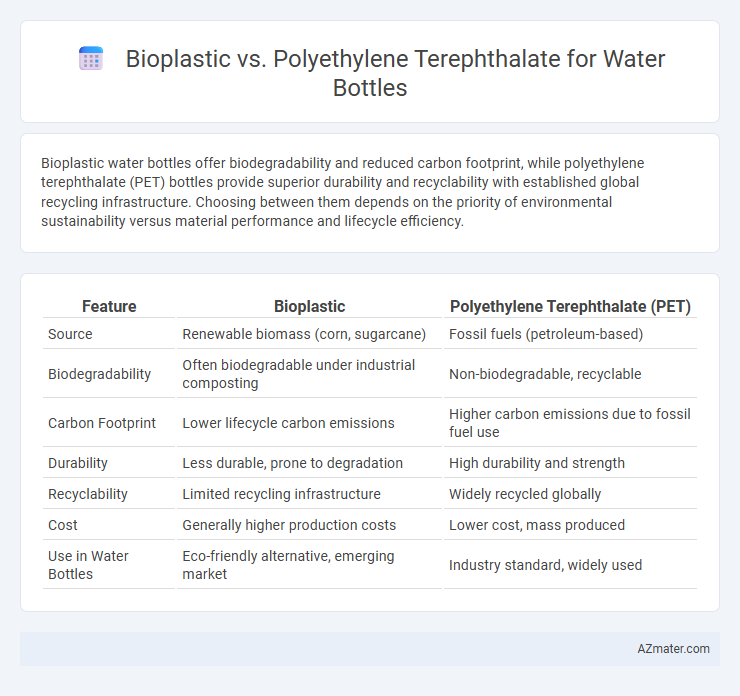Bioplastic water bottles offer biodegradability and reduced carbon footprint, while polyethylene terephthalate (PET) bottles provide superior durability and recyclability with established global recycling infrastructure. Choosing between them depends on the priority of environmental sustainability versus material performance and lifecycle efficiency.
Table of Comparison
| Feature | Bioplastic | Polyethylene Terephthalate (PET) |
|---|---|---|
| Source | Renewable biomass (corn, sugarcane) | Fossil fuels (petroleum-based) |
| Biodegradability | Often biodegradable under industrial composting | Non-biodegradable, recyclable |
| Carbon Footprint | Lower lifecycle carbon emissions | Higher carbon emissions due to fossil fuel use |
| Durability | Less durable, prone to degradation | High durability and strength |
| Recyclability | Limited recycling infrastructure | Widely recycled globally |
| Cost | Generally higher production costs | Lower cost, mass produced |
| Use in Water Bottles | Eco-friendly alternative, emerging market | Industry standard, widely used |
Introduction to Bioplastic and Polyethylene Terephthalate
Bioplastic, derived from renewable biomass sources like cornstarch or sugarcane, offers a biodegradable alternative to traditional plastics, reducing environmental impact in water bottle production. Polyethylene terephthalate (PET), a petroleum-based polymer, is widely used for its strength, clarity, and recyclability in water bottles, making it a market standard. Comparing bioplastic and PET involves evaluating their environmental footprint, durability, and recycling processes to determine the most sustainable option for water container manufacturing.
Composition and Manufacturing Processes
Bioplastic water bottles are primarily composed of renewable plant-based materials such as cornstarch, sugarcane, or cellulose, and undergo fermentation or polymerization processes that produce biodegradable polymers like polylactic acid (PLA). In contrast, Polyethylene Terephthalate (PET) bottles are synthesized through the polymerization of ethylene glycol and terephthalic acid derived from petrochemical sources, involving high-temperature reactions and extrusion techniques. The manufacturing of bioplastic bottles emphasizes sustainable feedstocks and lower carbon emissions, whereas PET production relies on fossil fuels and energy-intensive operations.
Environmental Impact Comparison
Bioplastic water bottles, derived from renewable plant-based materials such as corn starch or sugarcane, offer a reduced carbon footprint and enhanced biodegradability compared to polyethylene terephthalate (PET) bottles, which are petroleum-based and contribute significantly to plastic pollution. PET bottles, while recyclable, often persist in landfills and oceans for hundreds of years, leading to microplastic contamination and harm to marine ecosystems. The environmental impact of bioplastics depends on factors like agricultural resource use and composting infrastructure, but they generally present a more sustainable alternative by lowering greenhouse gas emissions and reducing reliance on fossil fuels.
Biodegradability and Compostability
Bioplastic water bottles offer superior biodegradability compared to polyethylene terephthalate (PET), breaking down naturally in industrial composting environments within months, whereas PET can persist in landfills for centuries. Bioplastics derived from renewable resources like polylactic acid (PLA) support compostability and reduce microplastic pollution, contrasting with the synthetic nature of PET, which is resistant to microbial degradation. The ecological benefits of bioplastic water bottles hinge on proper composting infrastructure, highlighting the importance of waste management systems to maximize biodegradability and environmental impact reduction.
Mechanical and Physical Properties
Bioplastic water bottles typically exhibit lower tensile strength and thermal resistance compared to polyethylene terephthalate (PET), which boasts a tensile strength of around 55-75 MPa and a melting point near 260degC. PET's superior barrier properties reduce oxygen and moisture permeability, enhancing water preservation, whereas bioplastics often have higher permeability rates, impacting shelf life. The mechanical flexibility and impact resistance of PET make it more suitable for mass production and recycling, while bioplastics offer biodegradability but usually sacrifice durability and rigidity.
Water Bottle Performance and Shelf Life
Bioplastic water bottles often exhibit lower barrier properties compared to polyethylene terephthalate (PET), leading to reduced resistance to oxygen and moisture permeation that can affect water quality and shelf life. PET bottles provide superior structural strength, clarity, and longer shelf life due to their high barrier performance against gases and UV light degradation. The shelf life of bioplastic bottles typically ranges from a few months to one year, whereas PET water bottles maintain product integrity for up to 18-24 months under optimal storage conditions.
Recycling and End-of-Life Management
Bioplastic water bottles, derived from renewable resources such as cornstarch or sugarcane, offer compostability but face challenges in existing recycling infrastructure, often requiring industrial composting facilities to break down effectively. Polyethylene Terephthalate (PET) bottles dominate recycling programs with well-established mechanical and chemical recycling methods, enabling widespread material recovery and circular economy practices. End-of-life management for PET emphasizes closed-loop recycling to reduce plastic waste, whereas bioplastics necessitate tailored waste streams to prevent contamination and ensure environmental benefits.
Economic and Market Considerations
Bioplastic water bottles generally incur higher production costs than polyethylene terephthalate (PET) due to raw material expenses and less established manufacturing infrastructure, impacting their competitiveness in price-sensitive markets. PET dominates the global water bottle market with over 80% share, benefiting from well-developed recycling systems and economies of scale that drive down costs. Market demand for sustainable packaging is growing, yet bioplastics face challenges in scalability and consumer adoption, limiting their current economic viability compared to traditional PET bottles.
Consumer Perceptions and Adoption
Consumer perceptions of bioplastic water bottles emphasize environmental benefits such as biodegradability and reduced carbon footprint, driving increased adoption among eco-conscious buyers. In contrast, polyethylene terephthalate (PET) bottles are favored for their durability, clarity, and recyclability but face criticism for reliance on fossil fuels and microplastic pollution. Market adoption trends indicate growing demand for bioplastics in premium and health-focused segments, while PET remains dominant due to established infrastructure and cost-effectiveness.
Future Outlook for Sustainable Water Bottles
Bioplastics offer a promising future for sustainable water bottles due to their biodegradability and reduced carbon footprint compared to traditional Polyethylene Terephthalate (PET). Innovations in biopolymer composites and enhanced recycling technologies aim to overcome current limitations such as durability and scalability. The shift towards circular economy models and consumer demand for eco-friendly packaging drive investment in sustainable materials, positioning bioplastic as a key player in reducing plastic pollution and resource depletion.

Infographic: Bioplastic vs Polyethylene Terephthalate for Water Bottle
 azmater.com
azmater.com